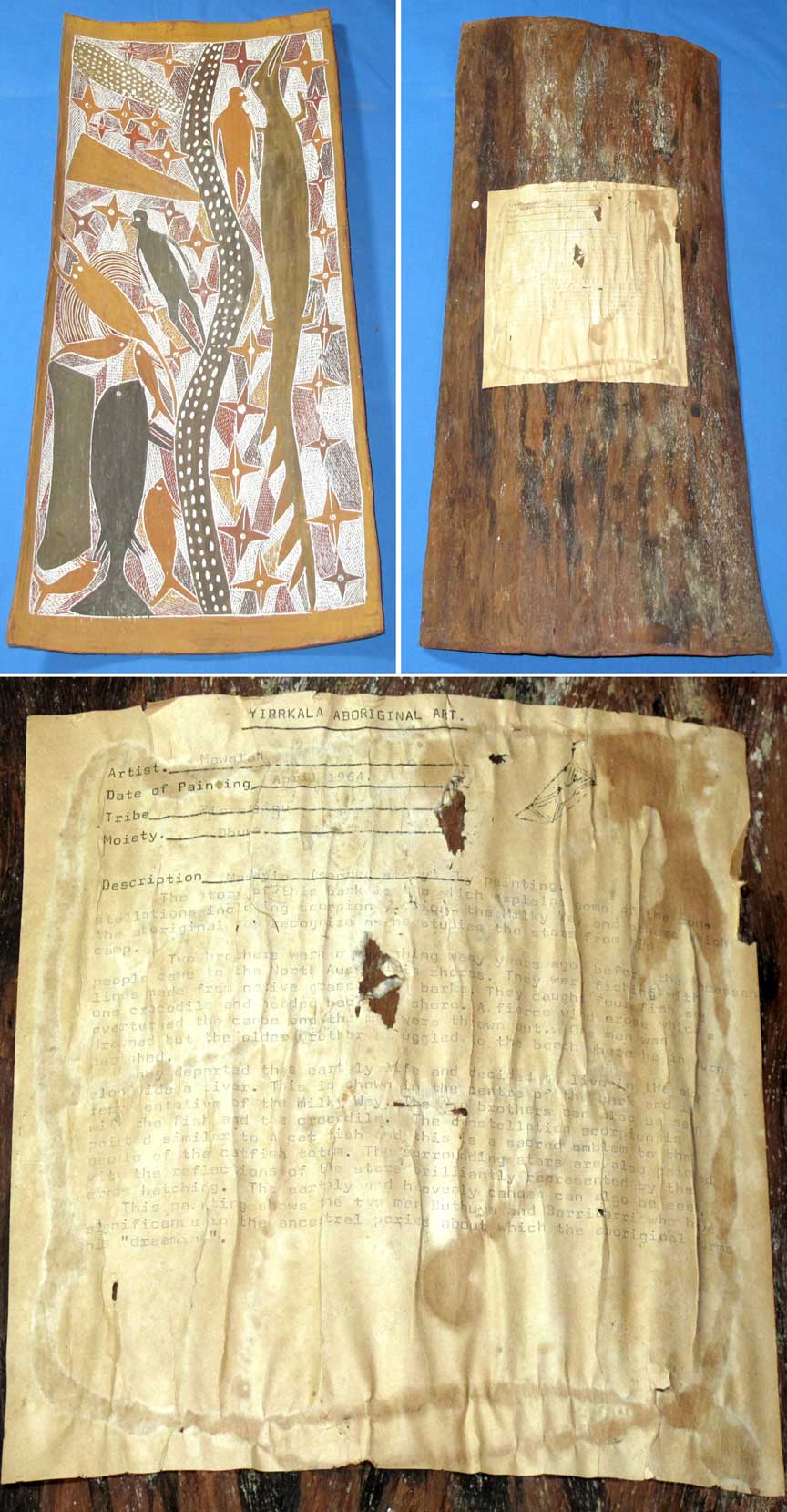Item A78
This Item was Sold on 28 October
2016 for $330
Similar artifacts for sale are often found on the Aboriginal
Artifacts web page.
Historical Pricing information for this item and similar artifacts can be found at: Historical Artifact Prices.
|
This medium size stringybark painting was purchased from the Barclay Gallery in 1984. The theme of this bark is both aquatic and celestial. The back of the bark has a sheet of paper with provenance. The sheet is difficult to read because it has darkened with age and it is wrinkled because of moisture loss in the wood interface over the past 50 years, but there is enough information to identify the artist as Mawalan 1 Marika (c. 1908 - 1967) from the Yirrkala Aboriginal Art Center in Arnhem Land, Northern Territories. The provenance sheet tells the Aboriginal story about two brothers from the Mallucan straights were fishing from a canoe using lines made of bark and grass. They caught 4 fish. A fierce wind came up and the men found themselves in the sea. One drowned and the other made it to shore, but he later died. The men decided it was better to live in the heavens among the Milky Way and stars. The constellation for the scorpion and crocodile, baramundi, catfish and more can be seen in the painting with the men. this provenance sheet really adds value to this old bark painting. There is a small amount of natural curl to this bark because it was not constrained flat with restraining sticks, but there are no cracks or damage to the paint. Overall, it is a very nice bark painting, one of the best that I have seen. About Mawalan Marika from the National Museum of Australia Mawalan 1 Marika was a highly influential ceremonial leader, political activist and artist. He was the leader of the Rirratjingu clan when the Yirrkala Mission was established on his Rirratjingu clan land in 1936. As a result he became a pivotal spokesman for his people and negotiator with the non-Indigenous world. He saw art as a form of advocacy that could promote a better understanding and appreciation of the Yolngu world. He helped shape the commercial bark painting movement at the mission especially during the 1950s when there was greater demand for more important religious stories. He contributed to the remarkable set of 365 crayon drawings for Ronald and Catherine Berndt in 1947, painted large barks for the Art Gallery of New South Wales and in 1956 won a prize in the Leroy-Alcorso textile design competition. He also contributed to the Yirrkala church panels and helped send the famous bark petition to the federal government as part of his land rights struggle. He was the founder of the Marika artistic dynasty who broke convention by teaching his oldest daughters how to paint along with his sons. This paved the way for Yolngu women to eventually establish themselves as painters in their own right and today this legacy is continued on by his daughters Banduk and Dhuwarrwarr. Art has played an important and sustained part in the Marika family's lives, which led Wally Caruana, the former Curator of Aboriginal Art at the National Gallery of Australia, to liken them to the Boyd dynasty. Mawalan 1 and his brothers Mathaman, Milirrpum and Roy Dadaynga Marika were all accomplished artists and passionate advocates of Indigenous rights. It was their involvement in the historic Gove Land Right Case that led to the passing of the first land rights legislation in Australia. Mawalan's son Wandjuk Marika, was also a prolific artist and tireless ambassador for his people and the first Chairman of the Australia Council's Aboriginal Arts Board. Wandjuk's son Mawalan 2 Marika and his sisters Banduk and Dhuwarrwarr Marika, Milirrpum's son Wanyubi Marika, Mathaman's daughter Yalmay and Dhuwarrwarra's son Barrmula Yunupingu are also talented practitioners proudly carrying on their family's cultural legacy while embracing new media and innovative ways of depicting their stories. All of these artists feature in the Yalangbara: Art of the Djang'kawu exhibition. |

How to Order | Back to: Aboriginal Artifacts | Collectable Artifacts | Historical Artifact Prices | contact: Ted Bailey